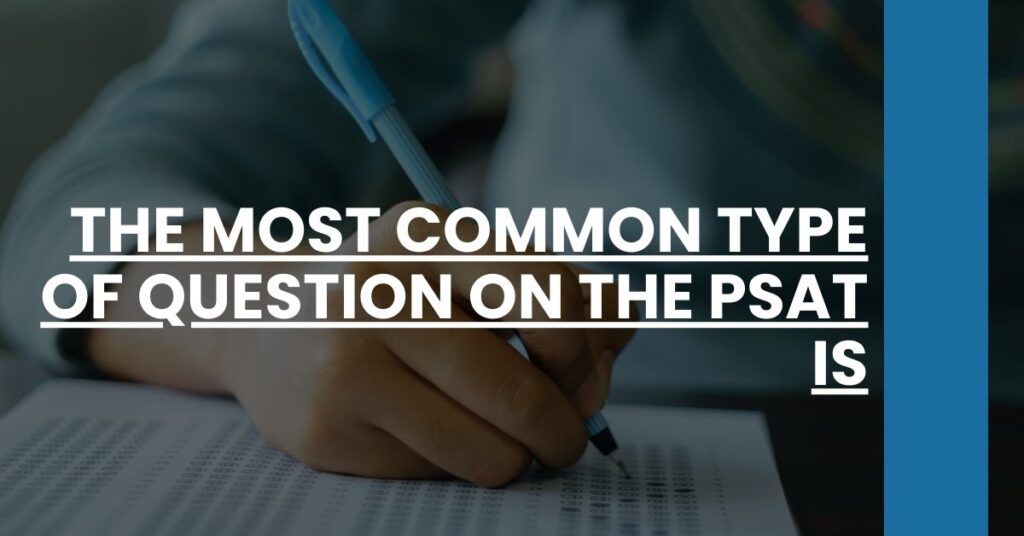The most common type of question on the PSAT is the multiple-choice question, featured predominantly across all sections of the exam.
From interpreting texts in the Evidence-Based Reading section to correcting grammatical errors in the Writing and Language portion, and solving equations or word problems in Math, multiple-choice questions are your constant companion.
In this article, you’ll learn:
- Key insights into the PSAT multiple-choice format
- Effective strategies to tackle these questions
- Practical tips to boost your confidence and performance on test day
Equip yourself with the know-how to navigate the PSAT’s most common challenge, and set the stage for a successful test experience!
- Introduction
- Understanding the PSAT
- The PSAT Question Types Explained
- Evidence-Based Reading: Decoding the Dominant Question Type
- Writing and Language: Understanding the Core Question Type
- Concordance Between PSAT and SAT Question Types
- Math Section Breakdown: Common Question Archetypes
- Strategies for Tackling the Most Frequent PSAT Questions
- The Impact of Question Type Frequency on PSAT Preparation
- Conclusion
Introduction
Navigating the terrain of standardized testing can be daunting, but one beacon that consistently guides students towards success is familiarity with the question types they’ll encounter. In particular, when facing the Preliminary SAT (PSAT), arming yourself with knowledge about the most common type of question can give you a significant edge. This guide will stoke the fires of your PSAT mastery, illuminating the paths commonly trodden by question types in each section and offering strategies to conquer them. So let’s embark on this journey to unlock the secrets of the PSAT.
Understanding the PSAT
You’re on the threshold of your college journey, and the PSAT stands as a gateway, testing your readiness and opening doors to scholarship opportunities. It’s a standardized test that mirrors the SAT in structure but is less intimidating—think of it as a rehearsal where the stakes are not as high, yet the performance is just as critical.
Structured into three main sections—Evidence-Based Reading, Writing and Language, and Math—the PSAT seeks to measure your prowess in comprehension, grammar, and mathematical reasoning. And here’s something to note: the most common type of question across these sections is multiple-choice. That’s right, you’ll be flexing your pencil on a familiar format that is all about finding the one best answer from a set of options.
For more on the structure and importance of the PSAT, consider diving into this comprehensive overview.
The PSAT Question Types Explained
Curious about what lies ahead on the PSAT? Let’s break down the terrain section by section. Across the board, you’ll find that each section of the PSAT predominantly features multiple-choice questions, but that’s just the surface.
In the Reading section, you’ll navigate through passages before wrestling with questions that test your comprehension and inferential skills. Writing and Language will have you don the editor’s hat, critically analyzing and correcting text. Meanwhile, the Math section launches a dual assault with both multiple-choice questions and grid-in responses, covering topics from algebra to data analysis.
Evidence-Based Reading: Decoding the Dominant Question Type
As you pore over each passage, you might find yourself asking, “What’s the most common type of question on the PSAT that I’ll see here?” Let’s decode this. The Evidence-Based Reading section primarily presents command of evidence questions. These are tasks where you’ll need to pinpoint the segment of text that supports your answer to a previous question.
Imagine you’re acting as a detective, sifting for clues within literature, history, and social science passages. This can be quite gratifying—after all, you have the evidence at your fingertips. To shine in this section, practice identifying textual evidence and drawing conclusions based on what you’ve read. The goal is simple: understand what you read to answer questions correctly.
If you’re itching for more details on conquering reading comprehension, this guide will be your ally in preparation.
Writing and Language: Understanding the Core Question Type
Welcome to what might just be the most fast-paced section of the PSAT. Here in the Writing and Language realm, you will find an array of multiple-choice questions inviting you to refine sentences and correct grammatical errors. The most common challenges you’ll tackle revolve around sentence structure, punctuation, and syntax.
You’re the mechanic in this scenario, tuning the engine of the text to run smoothly and efficiently. Focus on finding errors and inconsistencies that disrupt the clarity and flow. Remember that practice hones perfection, so familiarize yourself with the common grammatic rules and stylistic choices that this section probes.
For those hungry for specific insights and examples from the Writing and Language section, this resource will point you toward the path of grammatical enlightenment.
Let’s keep this engine running smoothly as we calculate our next move towards the most numeric of PSAT inquiries: the Math section.
Concordance Between PSAT and SAT Question Types
Before delving further into the PSAT universe, let’s pause to consider its kinship with the SAT. Both tests are cut from the same educational cloth, which means that mastering the PSAT provides more than just short-term gains—it sets the stage for your future SAT performance. That said, the most common type of question on the PSAT is also a feature star on the SAT: the multiple-choice question.
So, what does this sibling resemblance mean for you? By practicing with PSAT questions, you’re effectively preparing for both exams at once. However, do keep in mind that there are subtle differences in content level and pressure between the two. Yet, the overarching task remains the same: honing your ability to choose the right option from several tempting contenders.
To draw a clearer line between the two tests, you can explore the shared subjects and question frameworks in more detail here.
Math Section Breakdown: Common Question Archetypes
As you approach the Math section with sharpened pencils and a sharpened mind, be prepared for its dual nature. Beyond the ever-present multiple-choice questions, the Math section throws in the added twist of student-produced responses, also known as grid-ins. These questions require you to calculate an answer and record it on a grid, instead of simply recognizing it among given choices. It’s just another way the PSAT tests not just your knowledge, but your precision and confidence in it.
Remember, the topics can range from basic algebra to more advanced equations, so you’ll want to establish a solid foundation across the mathematical spectrum. Don’t be intimidated — strategy is key. Tackle the easier questions first, and remember to review your calculations; accuracy is crucial, especially when you’re the one providing the answers without prompts.
For those determined to conquer each nook and cranny of the Math section, additional strategies and topic insights await your attention here.
Strategies for Tackling the Most Frequent PSAT Questions
By now, it’s clear that the most common type of question on the PSAT is the multiple-choice question. But knowing this is only half the battle. The real challenge lies in answering these questions correctly under the pressure of the ticking clock. To triumph, you must sharpen your strategy sword and shield yourself with time management skills.
One effective technique to adopt is the process of elimination. By systematically ruling out incorrect answers, you improve your odds of selecting the correct one. Additionally, practicing with timed sections can’t be overstressed. It’s one thing to know the answer, but it’s another to identify it swiftly and with certainty.
Beyond these tactics, engaging with practice tests under test-like conditions is invaluable. It will not only familiarize you with the format and pacing but also build the test-taking stamina necessary for success.
Delve deeper into these approaches and accumulate a trove of PSAT strategies here.
The Impact of Question Type Frequency on PSAT Preparation
Realize that understanding the most common type of question on the PSAT is more than academic trivia—it’s a beacon for your study focus. It’s a statistic that should influence your preparation trajectory, casting a spotlight on specific skills and strategies.
Emphasize practice on multiple-choice formats since these questions are the bread and butter of the PSAT. Additionally, train yourself in the art of quick yet accurate reading, and imbibe mathematical concepts until they’re second nature. These finely tuned skills can significantly enhance your performance, turning knowledge into a scannable, bubble-able answer.
For a primer on leveraging the PSAT’s structure to your advantage, consider perusing insights here.
Conclusion
As we draw this exploration to a close, remember that the often-encountered multiple-choice questions are the threads weaving through the fabric of the PSAT. Understanding and preparing for the most common type of question on the PSAT is crucial to your testing success. So armed now with detailed insights and proven strategies, remain diligent in your preparation. Your future collegiate self will thank you for the savvy study moves you make today.

